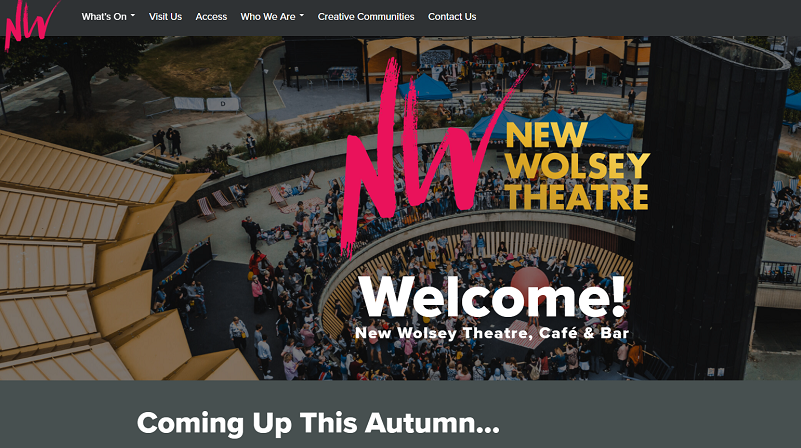5 min read
Creating great ticket booking experiences for arts audiences online

Audience members want to book theatre, music and event tickets online. But more than a transaction, your website’s often their first experience of your organisation - and a great online experience can be the first step in a great relationship. That’s why we believe a website is a journey, not a destination.
Customers want to book online
In 2021, 69% of transactions for tickets, donations, memberships and more were generated online. When we look at income from ticket sales alone it’s even higher - 71%, almost three quarters of overall income, was generated by theatres, music venues and visitor attractions through their websites.*
Your customers want to and will book online. And that should be no surprise, considering how familiar they now are with shopping online, for everything from groceries to holidays. But if they don’t enjoy the online experience, they’ll start dropping off - leading to a lost sale today, and lost donations, subscriptions or membership income in the longer term.
Your website is important not just because it can generate income. For many customers, the first interaction with an arts venue is through its website - so you want to create an online user experience that’s in line with your brand, your values, and the quality of welcome you’d offer to anyone walking through your doors.
Get your website working for your customers and your business
What makes a good website? It’s an online space in which your audience members can do what they want - find key information, make a booking or sign up for your communications - and which helps you to achieve your organisational priorities.
When you’re designing a new website or improving an existing one, ask yourself:
- As an arts organisation, what do we want to achieve?
- As supporters of the arts, what do our customers want to do online?
The answers will depend on the size and type of organisation, the type and frequency of events you put on, the age and interests of your patrons, and many more factors that you’ll know inside out.
A gallery with multiple timed entries every hour, hosting a single exhibition for the next six months and welcoming over 400 daily visitors will have very different needs to a 60 seat- fringe theater hosting a new show every second day.
If your business model is different to that of other organisations, shouldn’t the user experience you are providing online be different as well? Income generation is, of course, a vital business priority - but the first step in growing revenue is often to show customers the unique qualities of the user experience you can offer.
How your CRM system supports the online journey
There are various different ways in which your CRM and ticketing technology can connect with your online journey.
- Some systems hand visitors off to a separate, ‘white label’ site at the point of sale. From the moment they click ‘Book Now’, you’ll have limited scope to brand or configure their online experience.
- Other systems keep bookers on your site, integrating the checkout flow onto your own pages. This means that customers can buy tickets, subscriptions, memberships and more without leaving your site; you and your web developers can tailor their experience to match your brand and their interests, while your technology manages all the complex logic of the purchase.
With the second model, you’ll build up a complete picture of each customer through repeat visits, online behaviours and transactions. This data helps you create a more and more personalised experience with every visit, offering customers a seamless, reliable booking journey which helps them feel valued and helps you boost the overall value of each basket.
How 3 theatres and opera companies used their websites to improve customer experience and meet business priorities
This blog is based on in-person sessions which I presented at the recent Spektrix User Hubs and the Arts Marketing Association conference in the UK. Before those sessions, I spoke to a number of Spektrix users about their business priorities, and how their websites were supporting them on their journeys.
My business priority is that my customers with access needs are catered for
New Wolsey Theatre has a great journey throughout the purchase path, highlighting accessible performances. First of all there is a dedicated page that has filtered through all accessible performances, including events that are audio described, British Sign Language (BSL) interpreted and captioned. As a customer, I can see additional information for certain seats, such as ‘Best view for signer’; and by logging in I can be shown the most suitable seats for my individual needs.
My business priority is to increase my income through charitable giving

Honens International Piano Competition upsells and highlights different ways to give, through one-off or monthly donations. By combining multiple options on a single page, they create a seamless, visually appealing user experience and enable the donor to move between the two types of donation with a single click.
My business priority is to build customer loyalty
Opera Holland Park is placing an emphasis on converting bookers to members. Pricing displays both the full price and members' price, incentivising customers to become members. The web developers are able to use the value of the customer's basket to dynamically display how much they could save if they became a member, driving revenue and loyalty with every transaction.
Building a business case for investment in your website
First, let’s go back to where we started - 71% of theatre ticket income comes from online sales, and that number grows every year. That’s almost three quarters of your tickets sold without any demands on staff time, with data linked straight to their customer accounts, and with automated prompts in place to offer them the most relevant upsells, multibuys and giving campaigns.
You should be able to see your own figures easily, using data from your ticketing system in combination with Google Analytics. If you're using Spektrix run the Event Sales Report to explore how your different sales channels are used.
Use those figures, and take inspiration from the examples above, to build a business case for continuous investment in your website. A website’s not something you build once and never touch again. It should evolve with your business needs, adapt based on feedback from your customers, and grow with new technologies. A website is a journey, not a destination.
4 steps to kick off your web improvement journey
If you have 1 hour
If you can only dedicate one hour to your website, buy a ticket. Even better, get someone else who has never used your website before to do it - like a secret shopper!
Go through the journey as a customer and see whether you are able to complete each step without friction. Are there any buttons that could more clearly signpost customers to the next steps? Did you see anything you didn’t expect or found confusing? Was there anything you expected to see but didn’t appear? And most importantly, does it cater for the audiences you are trying to engage with?
If you have 1 day
If you can dedicate one day to your website, check your analytics. Where are your customers dropping off? Go back to that page and reconsider whether the language and styling are clear. Is there anything you can do to improve their experience?
If you’re using Spektrix, here’s our guidance for linking Google Universal Analytics using Google Tag Manager. We’re working on the Google Analytics 4 integration now, so keep an eye on our communications.
If you have 1 month
Work through all of the steps above, prioritise your findings, and make a case for investment so your web developers can help with anything which needs their expertise.
If you’re working with Spektrix - or thinking of doing so - we’re happy to help you develop a brief for a new or improved website or to find a new web developer. And once that’s in place, we’ll work directly with you or your web developer to continually improve your integrated customer journey - all as part of our inclusive service charge.
If you’re already using Spektrix and you need help with a brief, guidance on the best tools to support your business objectives, or technical support for your web developers, contact our Client Success team.
If you’re not yet using Spektrix, learn more about our integrated technology and inclusive support, helping you to imagine better web journeys for your patrons.
IMAGINE BETTER WEBSITES
Nina Primeraki is Client Integrations Lead at Spektrix
* Figures are based on Spektrix users globally

